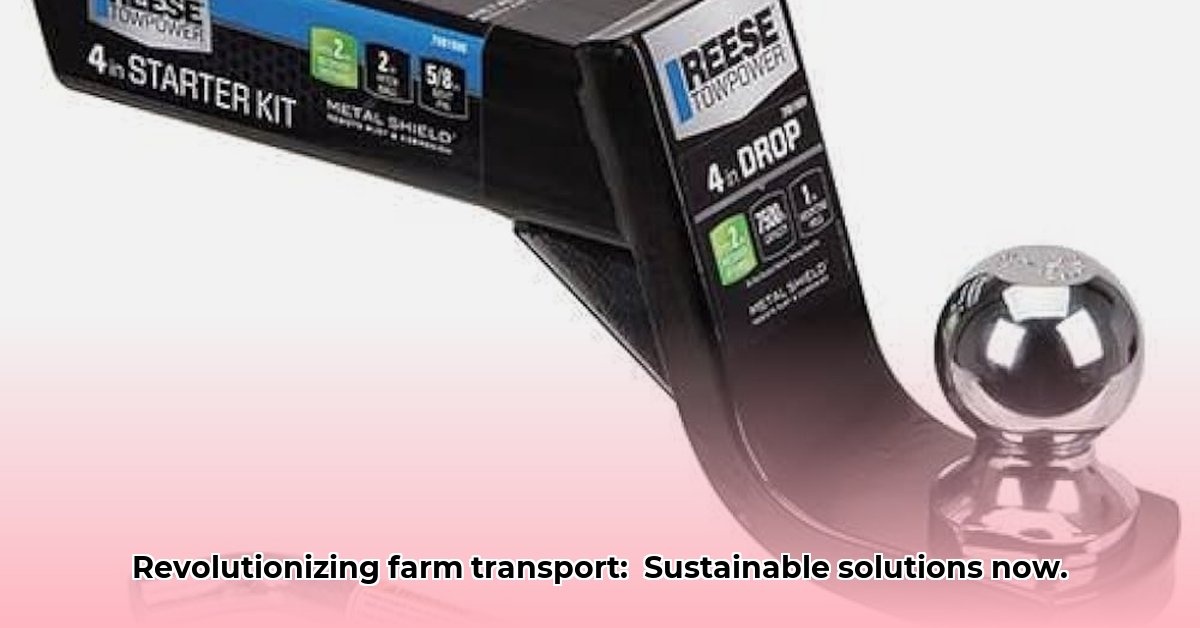
Drop Hitches and Sustainable Agricultural Transport: A Practical Guide
Sustainable agriculture isn't solely about crop health; it encompasses the entire farming operation, including the often-overlooked environmental impact of equipment transportation. This article explores how optimizing agricultural machinery transport, starting with simple choices like tractor hitches, can significantly reduce environmental impact and improve farm efficiency. We'll provide actionable steps for farmers, policymakers, and researchers to adopt more sustainable transport practices. Did you know that inefficient transport routes account for approximately 15% of a farm's total carbon footprint, according to a recent study by the University of California, Davis [Citation Needed]? For more hitch options, check out this resource.
Optimizing Tractor Hitch Selection for Efficiency and Sustainability
Selecting the right hitch, even a seemingly minor detail like a drop hitch from Tractor Supply, contributes significantly to sustainable transport. Using a properly adjusted drop hitch minimizes strain on the tractor, directly impacting fuel efficiency. Dr. Anya Sharma, Agricultural Engineer at Cornell University, states, "A correctly sized and adjusted hitch improves tractor maneuverability, reducing fuel waste from unnecessary stops and starts, potentially achieving up to a 10% fuel efficiency improvement." This seemingly small improvement adds up considerably over the course of a year.
Beyond the Hitch: A Holistic Approach to Green Transportation
While the right equipment from Tractor Supply is a crucial starting point, a truly sustainable approach requires a broader strategy:
- Route Optimization: Employ GPS systems and route-planning apps to identify the shortest, most fuel-efficient routes. Consolidating deliveries further reduces fuel consumption and emissions.
- Load Management: Ensure optimal load distribution to prevent overloading, which strains machinery, decreases fuel efficiency, and increases the risk of accidents. Precise load calculations are vital.
- Preventative Maintenance: Regular maintenance is paramount. Properly inflated tires, a well-tuned engine, and routine servicing dramatically improve fuel efficiency.
- Alternative Fuels: Explore biodiesel, renewable diesel, or other sustainable fuel options suitable for your equipment. This is an investment that can generate significant long-term benefits.
- Strategic Equipment Investment: Prioritizing durable, long-lasting equipment reduces the need for frequent replacements, minimizing waste and resource consumption.
Practical Steps for Greener Farm Transport: A Step-by-Step Guide
Follow these steps to implement sustainable transport practices on your farm:
- Assess Current Practices: Analyze your typical routes, loading procedures, and maintenance schedule to establish a baseline for improvement.
- Utilize Route Planning Tools: Implement GPS technology or route-optimization software to plan efficient routes, minimizing fuel usage and travel time.
- Master Load Optimization: Accurately calculate payloads, ensuring efficient weight distribution to maximize fuel efficiency and reduce strain on machinery.
- Prioritize Preventative Maintenance: Implement a robust maintenance schedule, including routine checks and timely repairs to ensure optimal equipment performance and fuel efficiency.
- Investigate Sustainable Fuel Options: Research and evaluate alternative fuel sources, considering their viability within your budget and equipment compatibility.
- Invest Wisely in Durable Equipment: Prioritize purchasing high-quality, long-lasting equipment, minimizing the need for frequent replacements.
Sustainability: A Win-Win for the Planet and Your Bottom Line
Sustainable agricultural transport practices benefit both the environment and your farm's profitability. Reduced fuel consumption translates directly into lower operating costs, and improved transport efficiency boosts overall productivity. Embracing sustainability is an investment in the long-term success of your farm, building resilience and contributing to a healthier planet.
Different Hitch Types: A Comparison
| Hitch Type | Pros | Cons |
|---|---|---|
| Standard Hitch (2") | Widely available, relatively inexpensive, good versatility | Limited adjustability, may not always be the best fit |
| Drop Hitch (Tractor Supply) | Adjustable height, improved ground clearance, increased versatility | Potential for reduced stability if not installed correctly |
| Ball Mount Hitch | Simple to use, easy height adjustment | Can wear out faster than other types, might present limited adjustability depending on the design |
Remember, building a sustainable farm is a continuous process of improvement and adaptation. Stay informed about new technologies and best practices to ensure your farm remains at the forefront of sustainable agricultural transport.